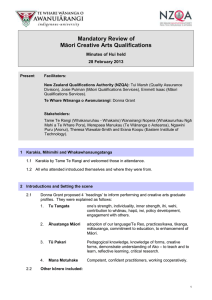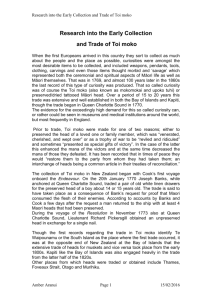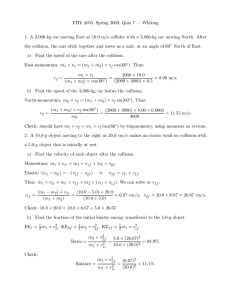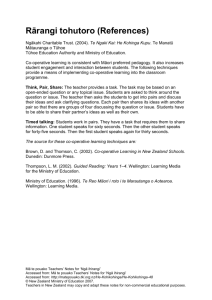Ngā Toi Māori Qualification Landscape (DOC, 124KB)
advertisement
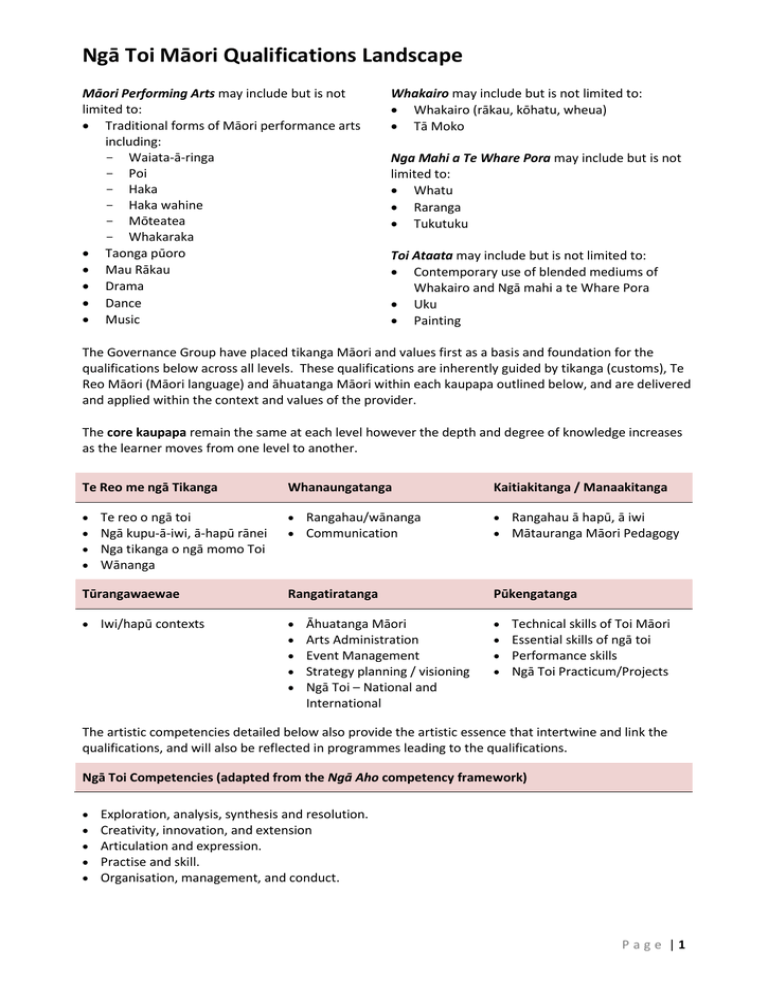
Ngā Toi Māori Qualifications Landscape Māori Performing Arts may include but is not limited to: Traditional forms of Māori performance arts including: - Waiata-ā-ringa - Poi - Haka - Haka wahine - Mōteatea - Whakaraka Taonga pūoro Mau Rākau Drama Dance Music Whakairo may include but is not limited to: Whakairo (rākau, kōhatu, wheua) Tā Moko Nga Mahi a Te Whare Pora may include but is not limited to: Whatu Raranga Tukutuku Toi Ataata may include but is not limited to: Contemporary use of blended mediums of Whakairo and Ngā mahi a te Whare Pora Uku Painting The Governance Group have placed tikanga Māori and values first as a basis and foundation for the qualifications below across all levels. These qualifications are inherently guided by tikanga (customs), Te Reo Māori (Māori language) and āhuatanga Māori within each kaupapa outlined below, and are delivered and applied within the context and values of the provider. The core kaupapa remain the same at each level however the depth and degree of knowledge increases as the learner moves from one level to another. Te Reo me ngā Tikanga Whanaungatanga Kaitiakitanga / Manaakitanga Rangahau/wānanga Communication Rangahau ā hapū, ā iwi Mātauranga Māori Pedagogy Tūrangawaewae Rangatiratanga Pūkengatanga Iwi/hapū contexts Te reo o ngā toi Ngā kupu-ā-iwi, ā-hapū rānei Nga tikanga o ngā momo Toi Wānanga Āhuatanga Māori Arts Administration Event Management Strategy planning / visioning Ngā Toi – National and International Technical skills of Toi Māori Essential skills of ngā toi Performance skills Ngā Toi Practicum/Projects The artistic competencies detailed below also provide the artistic essence that intertwine and link the qualifications, and will also be reflected in programmes leading to the qualifications. Ngā Toi Competencies (adapted from the Ngā Aho competency framework) Exploration, analysis, synthesis and resolution. Creativity, innovation, and extension Articulation and expression. Practise and skill. Organisation, management, and conduct. Page |1 Ngā Toi Māori Qualification Landscape Māori Performing Arts Ngā Mahi a Te Whare Pora Whakairo Toi Ataata Toi Te Tuhura Level 1 and 2 No qualifications, but standards available for use in the Senior Secondary sector. Pukenga Toi, Toi Studies (Performance), Āhuatanga Māori (te Reo, Tikanga) Skills and Knowledge Standards available for Senior Secondary School students Exploring Toi Māori concepts and ideas; safety; Entry level programme to develop basic skills in Ngā Toi Māori studies. Exploring ideas through variety of media and techniques recognize creative process; use aspects of cultural practice; whakapapa. Toi Ariki Level 3 (60 credits) Pukenga Toi, Toi Studies (Performance), Āhuatanga Māori (te Reo, Tikanga) Pukenga Performance Wānanga Pukenga Performance Wānanga Pukenga Performance Wānanga Pukenga Performance Wānanga Toi Urutapu Practicums/Projects Level 4 (120 credits) Pukenga Performance Wānanga Pukenga Performance Wānanga Pukenga Performance Wānanga Pukenga Performance Wānanga Level 5 (120 credits) Pukenga Performance Wānanga Pukenga Performance Wānanga Pukenga Performance Wānanga Pukenga Performance Wānanga Toi Ururoa Level 6 (120 credits) Practicums/Projects, Rangahau, Arts administration, Event Management, Legal Issues, Wānanga Pukenga Pukenga Pukenga Pukenga Performance Performance Performance Performance Wānanga Wānanga Wānanga Wānanga Education Those wanting to develop practical skills in Ngā Toi Māori and continue with further Tertiary study. Explore ‘hands on’ processes, design process to develop ideas, design elements of colour, line, tone, texture, shape, plan and volume, rangahau, ways to document and present ideas, and basic administration/ management skills. Those wanting to develop practical skills in Ngā Toi Māori and continue with further Tertiary study at the diploma or degree levels. Explore creativity and innovation with ‘hands on’ processes, design process to express ideas and design elements. Rangahau, ways to document and present ideas, and basic administration/ management skills. Introduction of a kaupapa study. Toi Ururangi Practicums/Projects, Contextual/kaupapa study Pathways Who is the qualification for? Those wanting to develop Nga Toi Māori (in specific strands) cultural, technical and commercial skills and continue into Degree level study or enter into self-employment /small business activity /commercial environments. Creative and media practice; cultural and contextual practice.; rangahau; business administration or small business management; project management; legal/IP; teaching. Employment Level 2 Toi Māori Certificate Level 4 Toi Māori Certificate Hapū/Iwi/ Hāpori General Toi Māori knowledge and skills Awareness of pūkenga and mātauranga-āhapū, ā-iwi. General Ngā Toi Assistant For example: Karakia Waiata Ngā kōrero. Self-employment, Tourism and teaching pathways Retention of pūkenga and mātauranga-āhapū, ā-iwi. For example: Karakia Waiata Whakapapa Ngā kōrero. Level 6 Toi Māori Diploma or Degree level qualifications Self-employment, Tourism and teaching pathways Creative and innovative application of pūkenga and mātauranga-ā-hapū, ā-iwi. For example: Karakia Waiata Whakapapa Ngā kōrero. Level 7 Degree and other Post Graduate studies. Cultural tourism facilitation, service sector industry, education, business, local and central government, consultancy. Teaching, arts administration, small business, contractor, self -employment, museum curator Application and expression of pūkenga and mātauranga-āhapū, ā-iwi. For example: Karakia Waiata Whakapapa Ngā kōrero tawhito. advisors Level 5 Toi Māori Diploma or Degree level qualifications *All of the Qualifications at Levels 3, 4, 5, and 6 are stranded. Page |2 Hei Whakamārama The proposed Toi Māori qualifications at Levels 1-3 focus on the foundation skills necessary to ensure successful study of Toi Māori in a hapu/iwi context and at the Tertiary level. The specific skills, knowledge, attributes and competencies for each of the strands within the qualifications will be expressed in more detail in the draft qualifications that will be distributed during the second consultation phase. The Levels of each of the qualifications has been given a Māori name to ensure a kaupapa Māori framework on which to base our qualifications. The names have been adapted from “He Oriori mō Tūteremoana” – a chant for Tuteremoana. Tuteremoana was a high chief and was a famous descendant of Tara, the eponymous ancestor of the Ngai Tara iwi. This oriori was composed for the tohi, or baptism, of Tuteremoana by his Grand Uncle Tuhotoariki. Tuteremoana lived nineteen or twenty generations ago, and resided at Te Rangitatau and Poitō pā in the area now known as Tarekina Bay, Miramar, in Wellington, not far from where the landscape was developed by the Governance Group. The beginning of the Oriori talks about Tane and his ascent of the heavens to retrieve the baskets of knowledge. “Whakarongo mai e tama. Kotahi tonu te hiring i kake ai Tane ki Tikitiki-o-Rangi; Ko te hiringa i te mahara. Ka kitea i reira ko Io-matua-te-kore-anake I a ia te Toi Ariki, Te Toi Urutapu Te Toi Uru Rangi, te Toi Uru Roa…” Those who would set out on such a spiritual journey would be confronted by many challenges, as Tane was, but for those who persist on the journey, knowledge and entitlement await. The same can also be said for those who embark on the journey in pursuit of matauranga and education. For the purposes of this Landscape, the Levels have been explained as follows: Toi Te Tuhura (Level 1 and 2) Toi Ariki (Level 3) Toi Urutapu (Level 4) Toi Ururangi (Level 5) Toi Ururoa (Level 6) Exploring the Arts Acknowledging the Arts as a gift from the Atua Acknowledging tikanga and the spiritual elements of the Arts Acknowledging the Arts as a gift from the heavens, and embarking on a higher level of thinking and creating. Acknowledging the source of all creation, and working at a level of high performance and creation, kia puta ko te ihi, te wehi, te wana. Page |3 Toi Te Tuhura (Level 1 and 2) Feedback from the initial review analysis offers no convincing evidence of a need for Toi Māori qualifications at these levels. However, there was support for the development or maintenance of individual assessment standards that can be utilised within secondary schools in support of the attainment of NCEA. The analysis took into account the development of achievement standards for Nga Toi within Te Marautanga o Aotearoa, however, it was identified that the point of difference of assessment standards is in the preparation of students for further learning pathways aligned to the Ngā Toi Māori qualifications. Toi Ariki (Level 3) Findings from the review, analysis, and survey identify a need for an introductory level qualification that provides a foundation for learners who have not engaged in academic study or who are considering Ngā Toi Māori as a possible career option. At this level learners are able to assess whether they have the ability to build their skills and knowledge and to progress within the Ngā Toi Māori sector. Some survey respondents identified Ngā Toi Māori as a viable option for learning skills and knowledge of tikanga and āhuatanga Māori, while for some the opportunity to learn the language and customs of whānau, hapū and iwi and cultural identity coupled with learning a specific kaupapa Toi were considered as important outcomes that could be attained through this kaupapa. These outcomes could align with hapū/Iwi development plans. The qualification will have as its basis basic skills and knowledge in the exploration, creation, knowledge and appreciation of Ngā Toi Māori. The qualification is made up of the following kaupapa at a basic to intermediate level: understanding of basic tikanga Māori as it applies to Ngā Toi Māori; Kupu, korero, and reo associated with Ngā Toi Māori; knowledge of media and hands-on process; development processes when making or performing the selected mahi Toi; basic research processes; basic safe practice. Page |4 Toi Urutapu (Level 4) The proposed qualifications at Levels 4 and 6 are stranded and focus on extending knowledge and skills in specific areas of Ngā Toi. Qualifications at these levels also include a practical/project component that will contribute towards 30%, and 50% of the credits for the qualification at levels 4, and 6 respectively. The review process and analysis supported the maintenance of a qualification at Level 4 which will pathway from the Level 3 qualification in the development of the learner’s skills and knowledge in the exploration and presentation of ideas, design processes and the production, exhibition and/or live performance of the specific kaupapa Toi. Level 4 will also provide an introduction to basic analysis and critical thinking. At this stage it is expected that learners have chosen to enter into higher level study of Ngā Toi Māori - this being the case – the level 4 qualification serves as an entry level qualification to the Level 6 qualifications, and will also pathway to degree level study. Some learners may opt to seek work on completion of this qualification. For learners whose primary interest is in Māori Performing Arts (MPA), this will be a possible exit point given that the MPA strand culminates in the acquisition of skills and knowledge in performance. Proposed New Zealand Certificate in Ngā Toi Māori (Level 4) Whanaungatanga Kaitiakitanga / Manaakitanga Rangatiratanga Te Reo me ngā Tikanga Pukengatanga Tūrangawaewae The qualification(s) will incorporate the Ngā Toi competencies: Exploration, analysis, synthesis and resolution. Creativity, innovation, and extension Articulation and expression. Practise and skill. Organisation, management, and conduct. Toi Ururangi (Level 5) Initially, because there was no evidence from the literature review or needs analysis that identified a distinct need for Ngā Toi Māori qualifications at Level 5 the Governance Group had not included a Level 5 qualification in the proposed landscape. However, initial feedback on the proposed landscape and data provided from Providers currently delivering Ngā Toi qualifications at Level 5 suggest that there is indeed a distinct need for a Level 5 qualification to ensure a clear pathway for students from Level 4 that will then lead them onto a Level 6 Diploma or Degree level qualification. The level 5 qualification will continue to explore the creative and innovative application of skills in a specific context or kaupapa. Proposed New Zealand Certificate in Ngā Toi Māori (Level 5) Whanaungatanga Kaitiakitanga / Manaakitanga Rangatiratanga Te Reo me ngā Tikanga Pukengatanga Tūrangawaewae Page |5 The qualification(s) will incorporate the Ngā Toi competencies: Exploration, analysis, synthesis and resolution. Creativity, innovation, and extension Articulation and expression. Practise and skill. Organisation, management, and conduct. Toi Ururoa (Level 6) The review process identified thirteen Level 6 qualifications currently in scope of this review. Uptake of these qualifications across three of the four targetted areas of Whakairo, Nga Mahi a Te Whare Pora and Toi Ataata noted a steady decline in uptake with one area having no qualifications completions since 2010. In contrast the Maori Performing Arts qualification has recorded steady uptake and qualifications completions since 2010 and indications from survey participants and the governance groups are that this trend will continue. The decision to offer a qualification offering a core group of essential skills and the option to choose a specific strand of the Ngā Toi Māori suite e.g. Ngā Mahi a Te Whare Pora, Whakairo, Toi Ataata or Māori Performing Arts addresses issues of low uptake and duplication. The stranded option also means that all four Ngā Toi areas are maintained and options made available for learners to progress to other strands of the qualification without the need to complete the core components of the qualification. Proposed New Zealand Diploma in Ngā Toi Māori (Level 6) Whanaungatanga Kaitiakitanga / Manaakitanga Rangatiratanga Tūrangawaewae Pukengatanga Te Reo me ngā Tikanga The qualification(s) will incorporate the Ngā Toi competencies: Exploration, analysis, synthesis and resolution. Creativity, innovation, and extension Articulation and expression. Practise and skill. Organisation, management, and conduct. Page |6
